Podcast 214: Heat-Pump Water Heaters, PVC Trim Plus Cedar Siding, and Historic Architectural Details
The FHB crew takes questions on choosing water heaters, mixing and matching exterior building materials, getting historic renovations right, and more
Follow the Fine Homebuilding Podcast on your favorite app. Subscribe now and don’t miss an episode:
 |
 |
Kiley, Matt, and Patrick hear from listeners about two very different projects–converting a 9000 sq. ft. house to net-zero and restoring a 200-year-old barn–before offering advice about how to choose an energy-efficient water heater, whether or not it’s acceptable to put composite trim on a house with wood clapboards, where to learn about period details so you don’t screw them up, and how to finish a concrete floor in a new basement workspace.
Listener Feedback:
Listener feedback #1
In episode 210 we asked is there anything inherently wrong with a deep-energy retrofit on a 9000 sq. ft. house?
Joseph from Central Texas writes, Hello, Hopefully my email isn’t too late. I have listened to the podcast since the beginning and enjoy the conversations.
My in laws live in the ultimate low energy home. They raised 3 kids in a 1960’s 1200 sq ft house and turned the A/C on only in the summer. The embodied energy in the home is extremely low. They made one modest remodel to add a laundry room. I bet their energy bill is $60 / month even though the house has minimal “green” energy improvements.
When I see monster “green” homes on “This Old House” or Matt Risinger’s YouTube channel, it makes me think it’s just a way for extremely wealthy people to feel better about their consumption.
I’ve heard on this podcast and elsewhere that the justification for energy standards in the building code is not for safety but for the betterment of society. So the same logic follows that the code could limit the size of a house per person for the betterment of society. Or anything over ~ 500 sq ft / person tax the hell out of them.
A 9K sq ft net zero home reminds me of a bathroom remodel I did in a mansion on Lake Travis. While I was there, the owner was installing a rain water collection system; a complex, expensive system to make him feel good about keeping his yard green in Central Texas. The funny thing was right behind his house was the ultimate rain water collection system, Lake Travis.
Take Care, Joseph
Related links:
- Facing the 2030 Challenge
- A Case for Resilient Design
- Climate Change for Builders: The Biggest Opportunity
Listener feedback #2
Brian writes, Hi guys, A couple years ago I sent in a question about my small barn (subject: “200 year old Barn/Shed… destroy or save?”) which you answered on the show. Well, not YOU exactly, the hosts were Justin, Brian and Rob back then. I wanted advice on restoring or tearing down this building. It was a split vote, but I decided to take Brian’s advice and save it. As promised, here’s an update: I raised the building on cribbing, poured new footings, installed a floor, and built new doors. There’s probably not a single true 90 degree angle in the place, but words like “level” and “plumb” are relative terms in a structure this old. Pics attached.
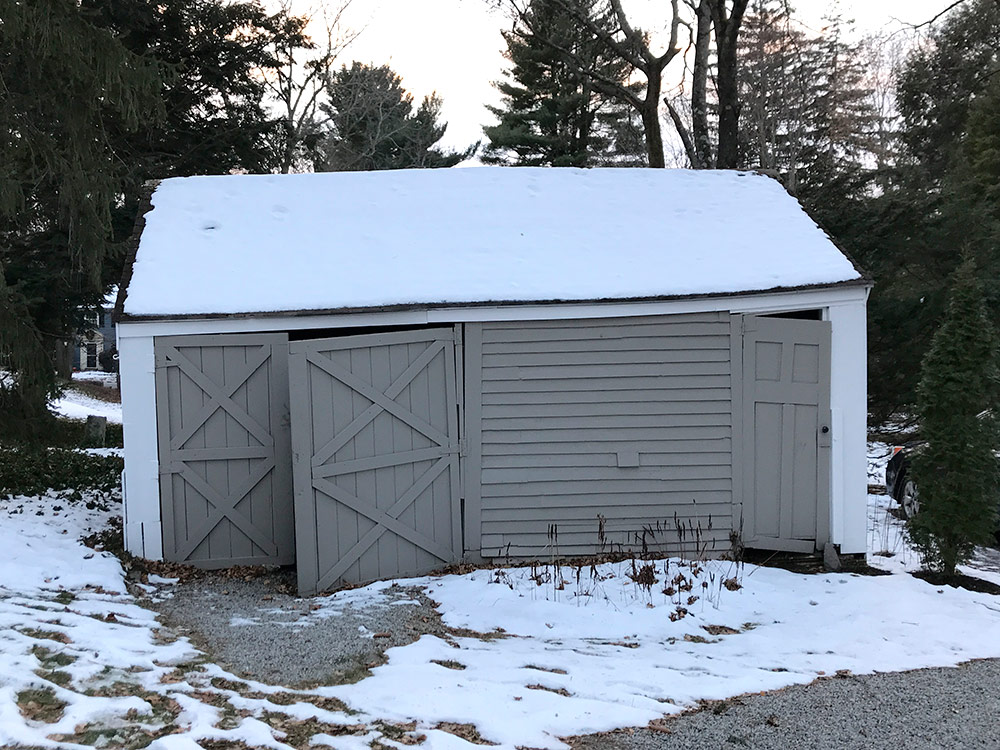 |
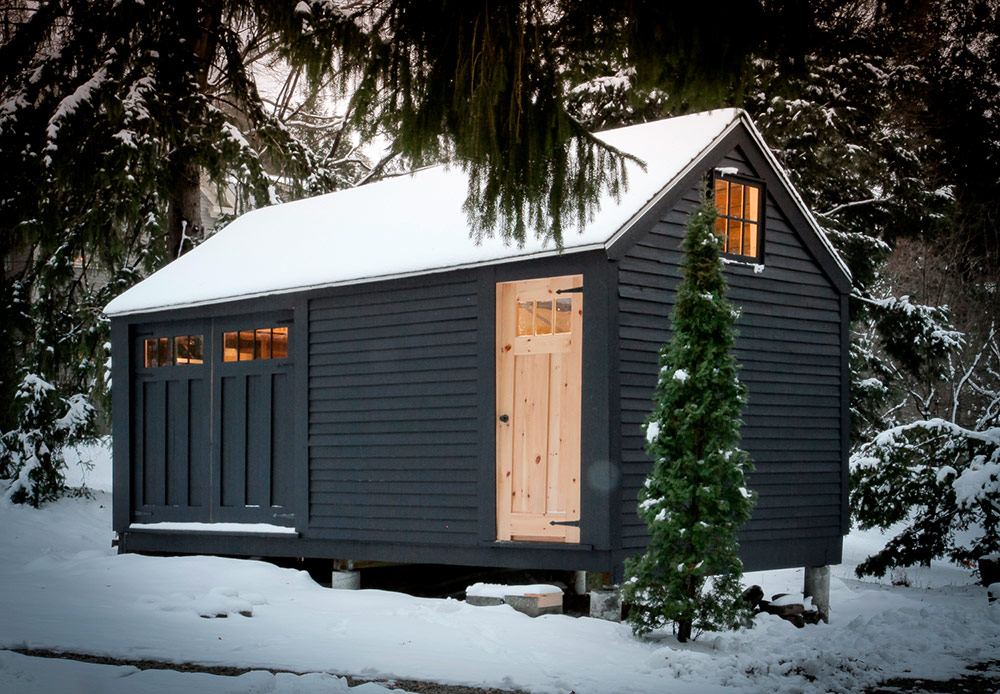 |
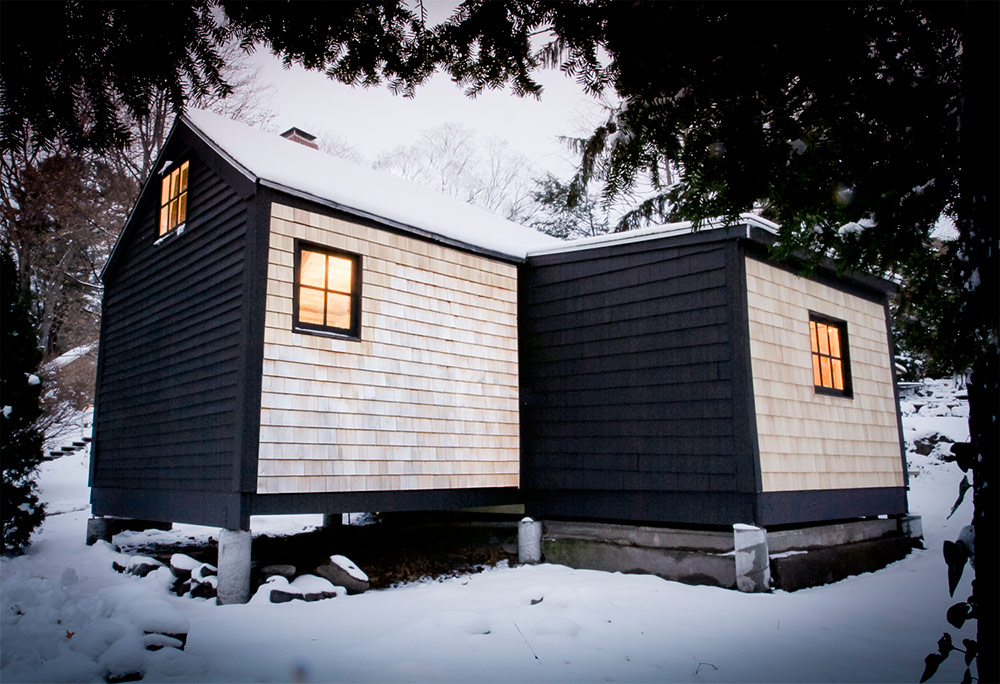 |
Love all the new voices on the podcast, though I miss listening to Justin haze everybody now and again. Keep up the great work.
I’m glad I went the restoration route. It definitely cost me less in terms of building materials, but there’s no doubt it was way more work. I’d done interior cabinetry work before, but I didn’t really have any experience house framing, so it was easier for me to wrap my head around repairing the existing building than tearing it down and starting from scratch. It was a great way to learn!
Related links:
Zachary writes, Hello FHB Podcast, I just listened to episode 211 and love the idea of a FHB spinner to help with making decisions so much that I decided to design one. Attached is both a PDF and image file of the wheel I designed. Feel free to use or completely disregard, either way is fine. I just had a bunch of fun making this.
Editor’s Projects:
Kiley’s oven fire
Matt’s new door update
Patrick’s Pittsburgh podcast meetup – He’s heading to Pittsburgh the week between Christmas and New Year’s and would like to have a podcast meetup somewhere in the Burgh. So if there are any listeners in the Pittsburgh area who are interested, please send an email to the FHB podcast and we’ll see if we can make it happen. Patrick said, “First round is on me! ..as long as we go someplace cheap.”
Related links:
Andy Grace’s 10 Things to Buy at Harbor Freight
We all get the Harbor Freight coupons in the mail. Most times, I find at least one worth clipping. Owing to the coupons I have tried more than a few Harbor Freight items over the years. Not all have wowed me, but some are absolute steals and I use them all the time. Here are my favorites.
- Flux brushes: I use a lot of flux brushes. Whether for soldering or woodworking glue-ups, these little brushes are a must-have. I’ve even used them to touch up paint, especially painting fastener heads with spray paint sprayed on a scrap board as a pallet. My big box sells 5 stubby (read worthless) acid brushes for $1.99. I get a 36 pack for $2.49.
- Tarps: Harbor Freight carries every size and grade of tarp imaginable. I should say that as roofers, our tarps are more the disposable variety than heirlooms and any deficit in quality goes unnoticed. At about 1/2 the price of the big box across the board, I keep a wide selection in the tool trailer. A 9’x19 blue tarp is $12.29
- Bungee cords, ropes and ratchet straps: I have a lot of trailers and trucks with ladder racks and something always needs to be tied down. Again, the price is half. You know those bungees and ratchet straps you sometimes see laying along the road? Those are probably mine. I lose them way before they have a chance to fail. 20 21” bungee cords are $13.99
- Extension cords: Wire gauge is wire gauge, right? 12 wire cords are about the same no matter what you pay for them. I have had great luck with HF cords and they even have some fancier options that are more supple with lighted and/or multi-plug ends. A 12-gauge, 50 ft triple tap cord is $42.15
- 99 cent flashlights: I have a gazillion of these. A pretty easy to find free coupon is available so I get one with every stop and stash them everywhere. Yeah, they are cheaply made but they come with batteries and any flashlight is a godsend when you’re in the dark.
- Casters: I have a small workshop, so I am forever building rolling tables and stands to make it more functional. HF has the best deal I’ve found, and the quality and selection are great. A 3” Poly swivel caster is $5.99
- Moving blankets: I literally can’t have enough of these. I do some handyman work and they are great for covering furniture and flooring. I can throw them in the washing machine when they get grungy too. The 40”x 70” will set you back $4.99.
- Small parts assortments: I keep several kits on hand of all the stuff that is most likely to go flying into the great beyond during dis or re-assembly. Things like woodruff keys, e-clips, snap rings and set screws. I probably wouldn’t leave any of these parts inside a transmission, but I think they are fine for most things, and they have saved my day more than once. A lifetime supply of roll pins costs $6.99
- Magnetic parts trays: I love these. I keep one in all my tool bags. They are great for all, “some assembly required” jobs with tiny parts. They are essential for ceiling fan assembly to keep track of those little lock washers for the blade screws. Sometimes a “free with any purchase” coupon floats around for these but if you can’t find one, you’ll have to shell out $2.99 for the 4” version, $3.99 for the 6”.
- 5-gallon buckets: We don’t do drywall in house anymore, so we don’t generate used buckets. I use a lot of buckets for tile, painting and basically whenever I want to carry up to 5 gallons of something in a container with a handle. I can get the price down to $2.28 each with the right coupon.
Question 1: What would you suggest for a shop floor?
George from Ossipee, NH writes, I am building a 900 ft2 shop in the basement of my new home. The floor is concrete. Would you suggest rubber mats over the concrete, wood sleepers with 2 layers of plywood, dimple mat with a commercial flooring, or ? FHB articles have suggested no vapor barrier to allow the floor to breathe. Is this especially true for newly poured floors? Should I wait six months before putting flooring down?
I would appreciate your advice. I am long time subscriber for FHB, FWW and FG. All three publications are great and the podcasts are a great source of info.
Related links:
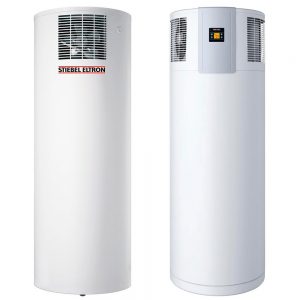
Question 2: What are the best heat-pump water heaters?
Dyami from Islip, NY writes, FHB crew, I know it’s been a few years since Heat Pump Water Heaters were reviewed, and if I remember correctly, the top rated one is no longer available.
What model would you currently recommend for a heat pump water heater?
Thanks for the help.
80-gallon model AeroTherm® Series heat pump water heater from Bradford White has a first hour rating of 87 gallons and recovers (90 deg rise) at 21 gallons per hour ($2000) 50 gal. model has 65 gal. first hour same recovery ($1400) (EF 3.4)
Bradford White “Energy Saver” 50 gal electric has 60 to 64 gallons first-hour rating and recovers at 21 gallons per hour ($640 Supply House) EF .95
Steible Eltron at Home Depot $2600 74 first hour rating and 3.4 EF
Related links:
- How it Works — Heat Pump Water Heaters (HPWHs)
- Choosing Among the Most Efficient Water Heaters
- Bradford White Buys GeoSpring Rights and Equipment
Question 3: Is it a good idea to pair PVC or Cement trim boards with cedar clapboards?
Greg from Cleveland writes, Hello FHB Podcast, I am restoring the cedar clapboards on the rear of my 100 year old house. I am removing the old siding, installing house wrap and reinstalling the old cedar onto vertical furring strips to allow for better ventilation of the wood.
Do you have any thoughts on using PVC or Cement trim boards in conjunction with cedar clapboards?
Because of the difficulty in sourcing quality old growth wood, I was thinking of trimming around my windows and vertically along the exterior house corners with 5/4 PVC trim board, and my concern was maybe the differential expansion and contraction of materials may lead to water penetration.
Any thoughts would be much appreciated.
Related links:
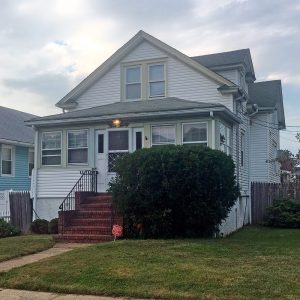 Question 4: What is the best resource for learning about period correct details for home renovations?
Question 4: What is the best resource for learning about period correct details for home renovations?

Jack writes, Hey all. love the podcast, thank you for all your insight and knowledge. I recently bought a 1920 cape in Long Island New York that is in need of some serious work. old mismatched roof, leaking windows, the works. it has some of the original 9 light basement windows and 6 over 1 double hungs on the main floor, most were replaced with terrible vinyl replacements. i am planning on a reroof, new windows and siding. where could i go to find reading materials on proper looks, and period appropriate style so I don’t completely butcher this renovation? i would love for it to look more historically accurate, this mismatch cobbled together “style” it has now it making me nuts. Thank you, Best regards.
Related Links:
- “Restoring Your Historic House” by Scott Hanson: Written for DIYers; loaded with info on style elements and hundreds of how-to photos, illustrations, and project examples
- Second Addition of “A Field Guide to American Houses” by Virginia McAlester
- “American House Styles”by John Milnes: explains the historical, cultural, and technical influences that shaped house styles
- Marvin’s line of historic replica windows and doors
End Note:
Come see us at The International Builder’s Show…it’s only about a month away!
If you can get to Las Vegas on January 21st, 22nd, or 23rd, come visit Fine Homebuilding at IBS booth C7543 at the Las Vegas Convention Center,
Get a FREE 3-Day Exhibit-Only pass courtesy of Fine Homebuilding.
THE PODCAST:
We’ll be recording the FHB Podcast several times at our booth throughout the event. If you email us in advance and tell us you’ll be in Vegas, we might even be able to interview you on the podcast!
Join us for a #KeepCraftAlive Meetup and Networking Event. Fine Homebuilding will be hosting a fun evening of networking and fundraising on Wednesday, January 22nd from 5:30-8:30PM at Craft + Community Bar and Grill in the Hardrock Hotel & Casino. Come support the Fine Homebuilding and SkillsUSA Scholarship Fund, enjoy craft beer, food and swag! Please REGISTER HERE.
We hope to see you there!
If you have any questions you would like us to dig into for a future show, shoot an email our way: [email protected].
If we use your question we’ll send you a FHB Podcast sticker!
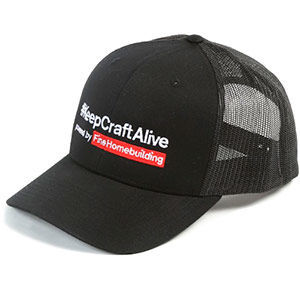 #KeepCraftAlive
#KeepCraftAlive
KeepCraftAlive hats help celebrate the value of true craftsmanship–plus 50% of all proceeds from every hat sold go to the #KeepCraftAlive Scholarship Fund, supported by Fine Homebuilding and SkillsUSA.
Buy a #KeepCraftAlive hat or t-shirt
This episode of the podcast is brought to you by Danner, Huber Engineered Woods, and Leatherman
We’d like to thank Danner, who sponsors this podcast because they believe in us. They believe in quality, and craftsmanship…but more than anything, they believe in the power of following your own path.
For more than 80 years Danner has made boots for those who have a trail to blaze. Boots like the Bull Run. Hand built in the USA with durable, full-grain leather uppers, and stitch-down construction for strength and stability. The Bull Run is built in a timeless design for both men and women with unmatched quality and durability that stands the test of time. The Bull Run boot by Danner offers iconic style and legendary craftsmanship for those who earn their independence.
You can find yours at Danner.com.
This episode is also brought to you by Huber Engineered Woods, makers of AdvanTech and ZIP System products.
If you’re going to the International Builder’s Show in Vegas, don’t miss Huber Engineered Woods – they will have two locations. At the Huber Wood booth in the Central Hall, be sure to attend the 3rd Annual “Best of Social Awards” with Matt Risinger, Wednesday at 3:30. Follow @huberwood on Instagram for information on pre-registration. And try ZIP System liquid flash, stretch tape and AdvanTech subfloor adhesive at The Prove It Tour product experience outside on your way to pick up your badge near Show Village.
This episode is also brought to you by Leatherman.
A Leatherman multi-tool is a problem solver: For outdoorsmen. For craftsmen. For around the house, and on the job. But it’s also the solution to one of life’s greatest challenges: Finding the perfect holiday gift. Check out the Leatherman FREE Collection, the next generation of the world’s most popular multi-tool. Or create a one-of-a-kind Leatherman, with custom graphics and personalization. Holiday gifts? Shop now at Leatherman.com. Problem solved.
Fine Homebuilding podcast listeners can now get 20% off anything in the Taunton store, including the Code Check series. These sturdy, spiral bound reference books will help you navigate the International Residential Code, The National Electric Code and the Universal Plumbing Code. Use the discount code FHBPODCAST to take advantage of this special offer.
We hope you will take advantage of a great offer for our podcast listeners: A special 20% off the discounted rate to subscribe to the Fine Homebuilding print magazine. That link goes to finehomebuilding.com/podoffer.
The show is driven by our listeners, so please subscribe and rate us on iTunes or Google Play, and if you have any questions you would like us to dig into for a future show, shoot an email our way: [email protected]. Also, be sure to follow Justin Fink and Fine Homebuilding on Instagram, and “like” the magazine on Facebook. Note that you can watch the show above, or on YouTube at the Fine Homebuilding YouTube Channel.
The Fine Homebuilding Podcast embodies Fine Homebuilding magazine’s commitment to the preservation of craftsmanship and the advancement of home performance in residential construction. The show is an informal but vigorous conversation about the techniques and principles that allow listeners to master their design and building challenges.
Other related links
-
- All FHB podcast show notes: FineHomebuilding.com/podcast.
- #KeepCraftAlive T-shirts and hats support scholarships for building trades students. So order some gear at KeepCraftAlive.org.
- The direct link to the online store is here.




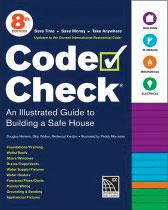
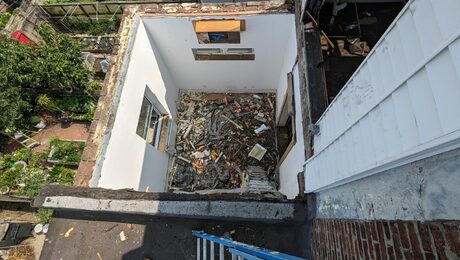
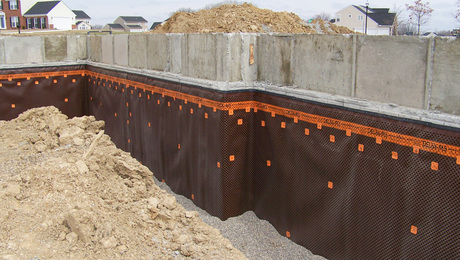


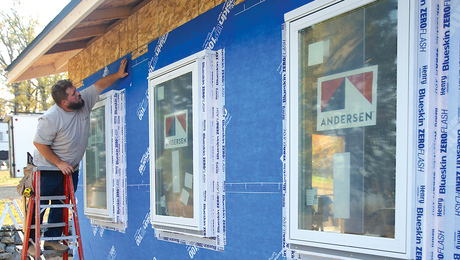

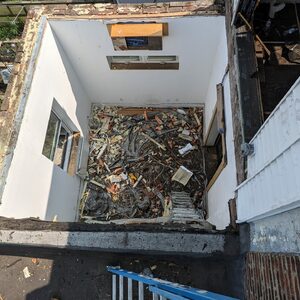

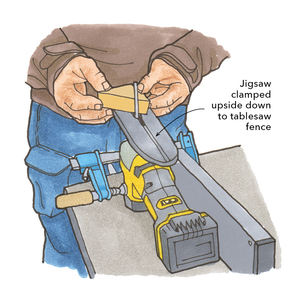

















View Comments
nice
Great one share